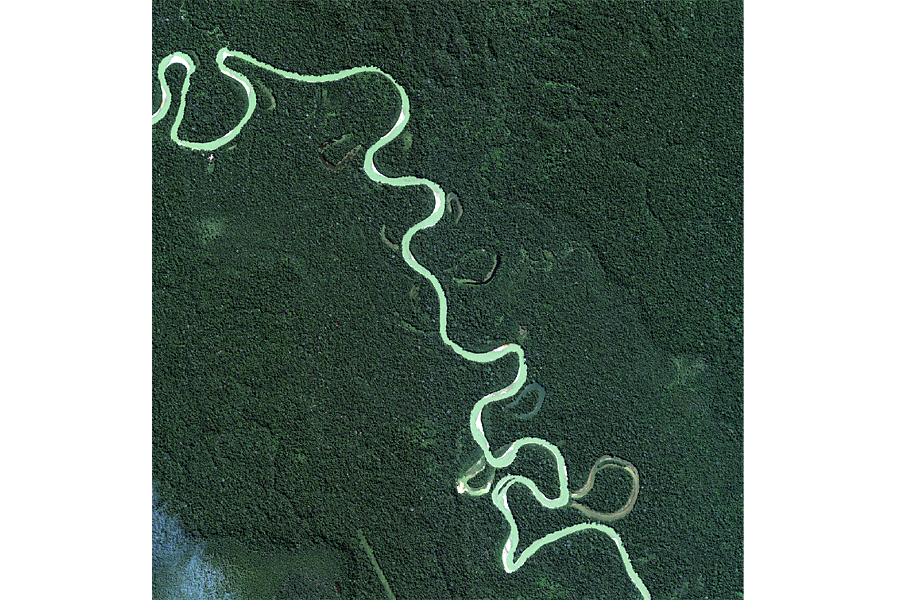How much did Amazonian natives mess with the rainforest?
Loading...
Humans, as we all know, have been encroaching on the Amazon rainforest for generations.
But when did the damage begin? And how did native populations affect the forest over 500 years ago, before European colonists arrived?
Gently, according to new research from an international team of biologists and anthropologists.
Sure, ancient populations impacted the ecosystems along rivers where they lived, but most of the rest of the forest was left pristine, says the new paper published Wednesday in the Journal of Biogeography.
In small, scattered areas, the researchers found evidence of "sophisticated peoples changing landscape, changing flora and fauna, but there were also very large areas where they had a very small to non-existent influence.”
"The occupation of the Amazon basin was heterogeneous," study lead author Mark Bush tells The Christian Science Monitor in an interview.
This research challenges two previous ideas, but reinforces the vulnerability of the Amazon rainforest to human encroachment.
For a long time, scholars believed that these pre-Columbian peoples had almost no impact on the rainforest, meaning the forest was practically untouched before the European conquistadors arrived.
But more recently, scientists have argued just the opposite.
"There’s been an emerging belief that these indigenous populations had such profound effect on the system that almost nothing can be considered to be natural within the Amazon," Dr. Bush explains.
That theory argues that indigenous peoples lived across the entire Amazon basin and influenced the whole ecosystem. The modern Amazon rainforest, therefore, has rebounded to its current wild state from being a managed forest.
"Our data conflicts with that," Bush says.
Instead of finding huge swaths of manipulated areas, he says, his colleagues found "distinct centers of manipulation, centered around major rivers," says Bush.
"The hinterlands between the rivers were barely touched at all," he argues.
The researchers looked for markers of human impact in different parts of the Amazon. They examined samples from many locations in the basin that could have contained traces of human life.
In extracted soil cores, they looked for charcoal fragments and terra preta, soil changed by human use of the land. They used radiocarbon dating techniques to confirm the age of the charcoal when they found it.
With this data, they mapped ancient human populations.
"We found charcoal ... close to rivers, and it would decay with distance away from the rivers," says Bush.
Their new maps of these historical civilizations could hold important implications for humans' current relationship to the dense forest.
"If you believe that everything until 500 years ago was being managed," says Bush, "then the system is obviously very resilient. It will bounce right back into this incredible ecosystem that we see today."
He adds, "If that’s the case, then it’s really quite okay to go in there and disturb the setting today, because it will bounce back again."
But if that idea is wrong, assuming resiliency in a fragile system could have devastating results. In this scenario, "We disturb the forest and it won’t come back," Bush warns.
So Bush suggests a more conservative approach. "These systems may be virtually millions of years old, and really not have been perturbed by people," he says. "If we’re wrong, then the worst that we do is delay using the system and disturbing it for another generation or so until knowledge catches up."
Or, as the authors write in the paper, "Human[s] have a long and complex history in Amazonia and dichotomies that describe Amazonia as ‘all used’ or ‘never used’ are overly simplistic and unrealistic."
What does it matter?
"It’s the biggest center of biodiversity on the planet," Bush says. "It’s the biggest single area of rainforest on the planet."
Amazonian trees hold vast stores of carbon in their trunks, branches, roots and leaves. When burned – the quickest and easiest way to "free up" rainforest land for development – they release that carbon as carbon dioxide into the atmosphere, contributing to global warming.
The Amazon faces rapid deforestation at the hands of humans, usually by logging or slash-and-burn clearcutting.
Knowing how humans historically interacted with the rainforest could help officials understand how vulnerable the Amazon is today.
The limited use patterns unearthed by Bush and his colleagues suggest that the Amazon rainforest could be ancient, with enormous regions never touched by human influence.
Bush described the Amazon basin as a "giant treasure trove of biodiversity."
He says, "I would hate to be the generation that undid that."






